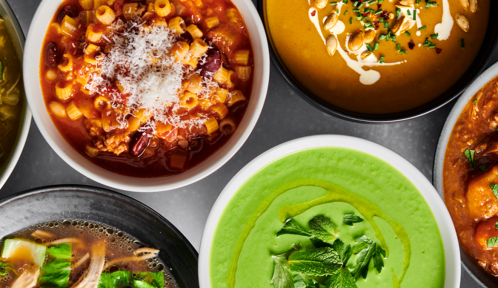Our editors independently select these products. Making a purchase through our links may earn Well+Good a commission
Tis the season for chunky sweaters, heated socks, and perhaps most importantly, steaming pots of soup. Few foods are more comforting on cold winter days, and luckily, most recipes make large serving sizes so you can enjoy them now… and later. Thankfully, soup is one of those meals that reheat well—like, really well. As such, learning a few tips for leftover soup storage is a smart way to be sure that batch of butternut squash soup tastes just as good the second time around.
Experts in This Article
registered dietitian and founder of Nutrition Starring You
And if you, like me, are often tempted to make multiple kinds of soups over a short period of time (because yes, you must keep things interesting for yourself), you may find that storing all that liquid goodness becomes something of a problem. The solution? The freezer; because yes, you can (and indeed should) freeze your extra soup.
To help you make the most of your leftovers for as long as possible, we’ve rounded up a few tips and tricks on freezing best practices.
How to freeze soup (without making a mess)
1. Freeze soup in single-serving containers
Freezing soup in single-serving containers or portions will help tremendously when it comes to reheating a serving for one. So, when you’re ready to dig into your reserved stash of minestrone (hi, freezable vegan meals), all you’ll need to do is reach for the single-servings you pre-portioned and heat it up. (Rather than having to defrost the entire batch in order to scoop out the amount you need.) That’s to say, this method is efficient and soup-er convenient.
The trick? Using freezer-safe storage containers. “Make sure to store in single-serve, freezer-safe containers or in freezer bags, removing as much air as possible,” says Lauren Harris-Pincus, RDN. Keep in mind that drastic changes in temperature can result in cracked glass containers, which is the last thing you’d want happen to your cherished leftovers. As such, it’s important to cool your soup completely before stashing it in the fridge, and more importantly, the freezer.
2. Don’t overfill your containers
Given that liquids expand when frozen, you’ll want to refrain from filling any container to its brim. Instead, leave a couple inches so that your soup can safely increase in size without exploding and creating a mess in your freezer (the ultimate ugh). As mentioned above, this is particularly pertinent when handling glass containers.
With that in mind, you may want to make use of silicone containers, like Souper Cubes (available on Amazon for $20) that are specifically designed for storing and freezing soup. The molds have four individual compartments (much like an ice tray) that help pre-portion servings, while providing a freezer-safe housing for your leftover soup. It also comes equipped with a lid, making storing soup an absolute mess-free breeze.
3. Line your freezer-safe containers with cling wrap
The key to freezing soup effectively is to keep out as much air as possible (which also helps to reduce the risk of freezer burn). A good way to do this is to line the top of your container with cling wrap—pressing down on the surface ever so gently to remove any air in between—before putting on the lid if you opt for jars over bags.
4. Flatten your freezer-safe bags before freezing
Constantly rearranging your freezer to fit all of your leftovers? Relying on reusable freezer bags can help with that. “I often freeze soups in re-sealable bags, then lay flat until frozen,” says Harris-Pincus. “Once hardened, they can be stacked to maximize storage. Make sure it’s already cold before you put it in the freezer to prevent freezer burn.”
To save space and avoid any leaks and spills once the bags go horizontal, we recommend Stasher Reusable Silicone Storage Bag ($18) that come in tons of shapes and sizes (and colors!), including one that stands up for mess-free storage. Plus, these reusable bags help cut down on single-use plastic waste.
5. Identify soups that you should and shouldn’t freeze
Not all soups are created equal when it comes to their ability to be frozen. For example, dairy-based soups aren’t as freezer-friendly, as the natural fats in dairy tend to separate when exposed to cold temperatures in the freezer, often resulting in a broken soup when reheated. Similarly, soups with lots of vegetables, pasta, or grains can turn very mushy and have an off-putting texture when thawed. On the other hand, soups that are heavy in beans or meat (like chili), are broth-based, or are pureed are great candidates for the freezer.
6. Date your soup
Food safety is always of the utmost importance, and you don’t want to stumble across soup years after the fact and be left wondering if it’s still okay to eat. To that end, be sure that you clearly mark your soups with their freeze date, and if helpful, a best-by date (generally somewhere in the three-to-six-month range).
Additionally, you may want to conduct the freezer burn test, to ensure the food is still in prime condition despite its frosted appearance. Although most food safety experts agree that freezer burn isn’t generally a cause for concern, if you suspect that the soup may have been subject to bacteria exposure then it’s safer to simply dispose of it. For example, if soup has been thawed and left out for hours (especially in an environment that’s 60ºF or warmer), then refrozen, it may have had exposure to bacterial growth.
7. Garnish your soups after thawing
We love reheating our soups in a big cast iron that allows for even heat distribution (Great Jones is a personal favorite) and then adding fresh basil, parsley, dill (or any other appropriate herb) to liven it back up. Garnishing your soups after thawing will ensure that these delicate herbs—that are prone to wilting when exposed to fluctuations in temperature—stay nice and crisp, and very flavorful once you’re ready to dig in.
8. Get creative with your leftover soup
Noshing on leftover soup is great and all, but you can always take things up a notch by taking advantage of these genius leftover soup ideas. In fact, you can use leftover soup to give grains, like quinoa or rice, even more flavor by using the stock as the cooking liquid. Have tons of creamy soup stashed away? Use it to make a casserole. And who doesn’t love a one-pot meal? You can easily turn soup into a one-pot pasta dish flavored with a luscious, creamy (leftover soup) sauce. The options are endless for your soup recipes in queue.
How long can you freeze soup safely?
Whenever handling leftovers, or any food for that matter, it’s important to keep food safety precautions in mind to prevent the spread of foodborne illness or bacterial growth. According to the U.S. Department of Agriculture (USDA), there are several steps you should to set yourself up for food safety success. For starters, ensuring foods are cooked to the appropriate internal temperatures before they’re stashed away is imperative. For this, keeping a food thermometer on hand is incredibly beneficial.
Additionally, prepared foods (including your leftover batch of soup) must be kept out of the “temperature danger zone” at all cost, aka temperatures between 40°F and 140°F. As a rule of thumb, the USDA suggests that leftovers be refrigerated within two hours of being removed from a heat source. Yet another reason why it’s important to cool soup completely before stashing it in the fridge. Pro tip: Transfer the soup to a metal bowl (or bain marie pot) and submerge it in an ice bath (without letting the water tip in), while stirring regularly to evenly cool the mixture. This will help expedite the chilling process, so you can get your leftover soup stashed away in the fridge even quicker.
Lastly, keep in mind that the USDA suggests keeping leftovers (like soup) in the refrigerator for no more than three to four days or frozen for up to three to four months to ensure peak freshness and optimal food safety.
Boost your immune system with this smokey carrot soup:
Sign Up for Our Daily Newsletter
Get all the latest in wellness, trends, food, fitness, beauty, and more delivered right to your inbox.
Got it, you've been added to our email list.










